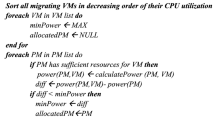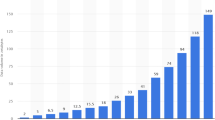Abstract
In the recent past, we are witnessing a proliferation in the number of web/mobile applications being hosted on a service provider’s Cloud. This has led to a surge in the traffic to the data centers hosting Virtual Machines (VM) running the cloud instances. In a cloud environment, a workload is defined as the requests coming in for the applications which are hosted on VM instances. Workload characterization helps in modeling the associations and correlations in the workload. Workload characterization models that are representative of the ground truth, can be leveraged for: (i) an accurate capacity planning, (ii) better resource utilization, (iii) reducing the spin-up times of VM instances, and (iv) maintaining compliance with Service Level Agreement (SLA). We propose a first-of-its-kind generative Dirichlet process-based model using Latent Dirichlet Allocation (LDA) for workload characterization. The characterization model is dependency preserving, regularized, and generative in nature, that relates the workload to the underlying application or user’s behavior that might have generated the workload. To evaluate the descriptive and predictive accuracies of the proposed model, we designed experiments using the Bit Brains Trace (BBT) and Alibaba Cluster Trace. The descriptive accuracy of the proposed workload characterization model is assessed by comparing a synthetic workload against the real workload using Pearson Correlation Coefficient (PCC) and Akaike Information Criterion (AIC) as the metrics. We have also performed statistical tests to assess the similarity between real workload and synthetic workload.









Similar content being viewed by others
Data availability statement
Real workload traces available at Bit Brains [1] and Alibaba cluster traces [24] have been used. The synthetic workloads generated from the proposed model are available in the GitHub repository that is accessible through https://github.com/sindhu1018.
References
Shen S, van Beek V, and Iosup A (2015) Statistical characterization of business-critical workloads hosted in cloud datacenters In proc 15th IEEE/ACM Int’l Symp. Cluster, Cloud, and Grid Computing (CCGRID 15)
Cano I, Aiyar S and Krishnamurthy A (2016) Characterizing private clouds: a large-scale empirical analysis of enterprise clusters In proc 7th ACM Symposium on Cloud Computing (SoCC 16)
Mishra A, Hellerstein J, Cirne W, Das C (2010) Towards characterizing cloud backend workloads: insights from google compute clusters. ACM SIGMETRICS Perform Eval Rev 37(4):34–41. https://doi.org/10.1145/1773394.1773400
Patel E, Kushwaha DS (2020) Clustering cloud workloads: K-Means vs Gaussian mixture model. Procedia Computer Sci 171:158–167. https://doi.org/10.1016/j.procs.2020.04.017
Blei D, Ng AY, Jordan MI (2003) Latent Dirichlet allocation. J Mach Learn Res 3:993–1022
Mahambre S, Kulkarni P, Bellur U, Chafle G and Deshpande D (2012) Workload characterization for capacity planning and performance management in IaaS cloud In IEEE International Conference on Cloud Computing in Emerging Markets (CCEM 12) https://doi.org/10.1109/CCEM.2012.6354624
Nemati H, Azhari SV, Shakeri M, Dagenais M (2021) Host-based virtual machine workload characterization using hypervisor trace mining. ACM Trans Model Perform Eval Comput Syst 6(1):1–25. https://doi.org/10.1145/3460197
Shishira S, Kandasamy A and Chandrasekaran K (2017) Workload characterization: survey of current approaches and research challenges In proc 7th International Conference on Computer and Communication Technology (ICCCT17)
Williams A, Arlitt M, Williamson C, Barker K (2005) Web workload characterization: ten years later. In: Tang X, Xu J, Chanson ST (eds) Web content delivery, vol 2. Springer, New York
Menasct A, D A, Almeida V, Fonseca R, and Mendes MA (1999) A methodology for workload characterization of E-commerce sites In proc ACM Conference on Electronic Commerce (EC 99)
Khan A, Yan X, Tao S, Anerousis N (2012) Workload characterization and prediction in the cloud: a multiple time series approach. IEEE Netw Oper Manag Symp. https://doi.org/10.1109/NOMS.2012.6212065
Aragon H, Braganza S, Boza EF, Parrales J, Abad CL (2019). Workload characterization of a software-as-a-service web application implemented with a microservices architecture In proc World Wide Web Conference (WWW ’19)
Shekhawat VS, Gautam A and Thakrar A (2018) Datacenter workload classification and characterization: an empirical approach In proc IEEE 13th International Conference on Industrial and Information Systems (ICIIS 18)
Birke R, Chen LY, Smirni E (2014) Multi-resource characterization and their (in) dependencies in production datacenters In 2014 IEEE Network Operations and Management Symposium (NOMS) (pp 1–6) IEEE
Jung G, Sharma N, Goetz F, Mukherjee T (2013) Cloud capability estimation and recommendation in black-box environments using benchmark-based approximation In 2013 IEEE Sixth International Conference on Cloud Computing (pp 293–300) IEEE
Tsyrulnikov M, Rakitko A (2019) Impact of non-stationarity on hybrid ensemble filters: a study with a doubly stochastic advection-diffusion-decay model. Q J R Meteorol Soc 145(722):2255–2271
Sturges HA (1926) The choice of a class interval. J Am Stat Assoc 21(153):65–66. https://doi.org/10.1080/01621459.1926.10502161
Sebah P, Gourdon X (2002) Introduction to the gamma function. Am J Sci Res. https://www.csie.ntu.edu.tw/~b89089/link/gammaFunction.pdf. Accessed 10 June 2022
Box GEP, Tiao GC (1973) Bayesian inference in statistical analysis. Wiley, USA
van Ravenzwaaij D, Cassey P, Brown SD (2018) A simple introduction to Markov Chain Monte-Carlo sampling. Psychon Bull Rev 25:143–154. https://doi.org/10.3758/s13423-016-1015-8
Gilks WR, Richardson S, Spiegelhalter DJ (eds) (1996) Markov chain Monte Carlo in practice. Chapman & Hall/CRC, Boca Raton
Teh YW, Newman D and Welling M (2006) A collapsed variational bayesian inference algorithm for latent dirichlet allocation In proc. 19th International Conference on Neural Information Processing Systems Advances in Neural Information Processing Systems
Darling WM (2011) A theoretical and practical implementation tutorial on topic modeling and gibbs sampling-school of computer science. In: Proc.49th annual meeting of the association for computational linguistics: human language technologies
Alibaba production cluster data. https://github.com/alibaba/clusterdata
Abadi M, Barham P, Chen J, Chen Z, Davis A, Dean J, Devin M, Ghemawat S, Irving G, Isard M, Kudlur M et al. (2016) TensorFlow: a system for large-scale machine learning In Proc USENIX OSDI
Paszke A, Gross S, Massa F, Lerer A, Bradbury J, Chanan G, Killeen T, Lin Z, Gimelshein N, Antiga L et al. (2019) PyTorch: an imperative style, high-performance deep learning library In Proc. NeurIPS
Zhu R, Zhao K, Yang H, Lin W, Zhou C, Ai B, Zhou J et al. (2019) Aligraph: a comprehensive graph neural network platform arXiv preprint arXiv:1902.08730
Weng Q, Xiao W, Yu Y, Wang W, Wang C, He J, Li Y, Zhang L, Lin W, Ding Y (2022) MLaaS in the wild: workload analysis and scheduling in large-scale heterogeneous GPU clusters to appear in the 19th USENIX Symposium on Networked Systems Design and Implementation (NSDI ’22), Renton, WA
Hastie T, Tibshirani R, Friedman J (2009) Model assessment and selection In: The elements of statistical learning Springer Series in Statistics. Springer, New York https://doi.org/10.1007/978-0-387-84858-7_7
Wilcoxon F (1992) Individual comparisons by ranking methods. In: Kotz S, Johnson NL (eds) Breakthroughs in statistics. Springer series in statistics, 1st edn. Springer, New York, pp 196–202
Acknowledgements
The authors would like to thank Mr. Gaurav and Mr. Sukhdev Singh who are undergraduate students in National Institute of Technology Andhra Pradesh, for their help with dataset collection and experimental setup.
Funding
This work has been sponsored by LinkedIn under a research grant for the project entitled “A Scalable Resource Requirement Prediction and Provisioning Framework for Elastic Cloud”.
Author information
Authors and Affiliations
Corresponding author
Additional information
Publisher's Note
Springer Nature remains neutral with regard to jurisdictional claims in published maps and institutional affiliations.
Rights and permissions
About this article
Cite this article
Sindhu, K., Seshadri, K. & Kollengode, C. Workload characterization and synthesis for cloud using generative stochastic processes. J Supercomput 78, 18825–18855 (2022). https://doi.org/10.1007/s11227-022-04597-y
Accepted:
Published:
Issue Date:
DOI: https://doi.org/10.1007/s11227-022-04597-y




